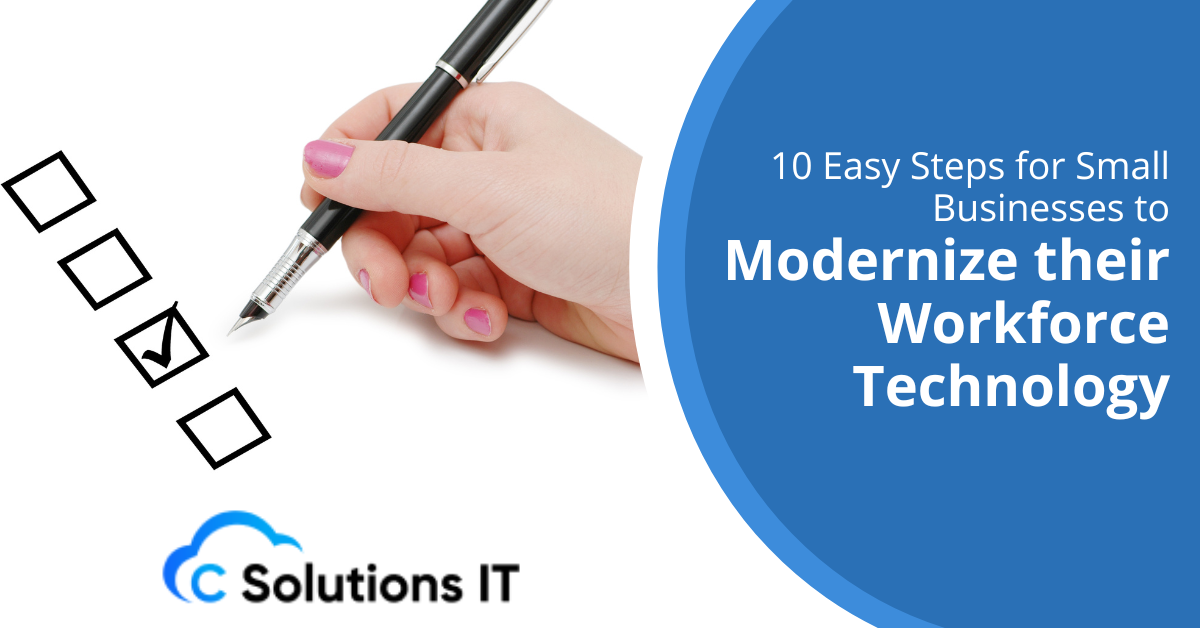10 Easy Steps for Small Businesses to Modernize their Workforce Technology

In today’s fast-paced business landscape, staying competitive requires small businesses to embrace modern technology and empower their workforce with the tools they need to thrive. Modernizing workforce technology enhances efficiency and boosts employee satisfaction and customer experience.
In this blog, we’ll explore 10 easy steps small businesses can take to modernize their workforce technology.
Step 1: Assess Current Technology Infrastructure
Begin by conducting a comprehensive assessment of your existing technology infrastructure. Identify any outdated systems, hardware, or software that could be hindering productivity. It’s crucial to understand your current technological landscape as a foundational step in crafting an effective strategy for modernization.
Step 2: Set Clear Objectives
Define clear objectives for your technology modernization efforts, whether improving collaboration, increasing productivity, or enhancing customer service; having well-defined goals will guide your decision-making.
Step 3: Embrace Cloud Computing
Embracing cloud computing is a pivotal step in modernizing small business operations. The transition to cloud-based solutions offers a transformative impact, providing scalability, enhanced flexibility, and accessibility. That allows employees to collaborate seamlessly from diverse locations, fostering a more dynamic and responsive working environment.
Small businesses should contemplate adopting cloud-based tools for various functions, including email communication, document management systems, and collaborative project platforms.
Step 4: Implement Mobile-Friendly Solutions
Giving your team mobile-enabled tools is essential to keep up with the demands of a fast-paced world today. Go for apps and platforms that can be used on mobile phones and tablets, thus enabling your team to stay in touch and work even when they are not at their workplace.
This small move is not just about being up-to-date but also about making work easy for your group. By selecting phone-compatible options, you ensure your staff stays in touch and maintains productivity wherever they are.
Step 5: Invest in Employee Training
Investing in your employees’ skills is essential to unlock the full potential of modern technology. Implement training programs that familiarize them with new tools, software, and processes. This investment enhances their proficiency and cultivates a positive attitude toward technological changes.
By providing your team with the knowledge they need, you empower them to embrace and leverage the benefits of updated technology. This commitment to ongoing learning enhances individual skill sets.
It nurtures a culture of adaptability and innovation within your small business, guaranteeing everyone embraces the advancements that propel success.
Step 6: Enhance Cybersecurity Measures
In an era of advancing technology, cybersecurity is paramount. Making the security of your digital assets a top priority is essential, and the key lies in implementing robust cybersecurity measures. That involves regular software updates, educating employees on cybersecurity best practices, and adopting secure communication tools. Keeping your systems up-to-date is like installing a digital shield against evolving threats.
Educating your team on cybersecurity practices ensures that everyone plays a role in safeguarding sensitive information. Additionally, incorporating secure communication tools adds an extra layer of protection. Your small business fortifies its defenses and maintains a secure digital environment by actively addressing cybersecurity concerns.
Step 7: Explore Automation Opportunities
Simplify repetitive tasks and enhance efficiency by exploring automation opportunities. Whether it involves automating customer communications, streamlining data entry, or optimizing inventory management, automation liberates time for employees to concentrate on more strategic and creative aspects of their roles.
Step 8: Foster Remote Work Capabilities
In response to the evolving needs of the modern workforce, fostering remote work capabilities has become imperative. Recognizing the value of flexibility and investing in technologies that facilitate remote collaboration are strategic moves. Consider incorporating video conferencing tools to bridge virtual distances, project management platforms for streamlined coordination, and virtual private networks (VPNs) to ensure secure remote access.
Embracing these technologies accommodates the desire for a flexible workforce and positions your small business to thrive in an environment where remote work is increasingly significant. By embracing remote work capabilities, you enhance your business’s adaptability, promoting a healthier work-life balance for your team.
Step 9: Leverage Data Analytics
Tap the potential of your business by using data effectively. Employing data analytics devices grants you access to critical information on customer trends, worker output, and general company activities. Adopting a data-driven approach enables you to make more strategic and informed decisions that positively impact your business.
This understanding is valuable in identifying opportunities for growth, process improvement, and efficiency gains. Data analytics is not just about numbers; it’s about equipping small businesses with the necessary knowledge to develop and apply innovative strategies for the continued success of their businesses.
Step 10: Continuously Evaluate and Evolve
Technology is ever-evolving, and so should your approach to workforce modernization. Regularly evaluate your technology solutions’ performance, seek employee feedback, and stay informed about emerging trends. Being adaptable and open to change will position your small business for long-term success in the modern business landscape.
Get Started Today
The imperative for small businesses to modernize their workforce technology is evident. No longer a luxury exclusive to large corporations, this necessity arises from the competitive demands of today’s business environment. Small business owners can navigate this transformation successfully by following the 10 easy steps outlined in this guide.
Empowering the workforce, enhancing operational efficiency, and embracing the digital era are not mere aspirations but tangible outcomes achievable through strategic modernization. Contact us at C Solutions IT for assistance today.
